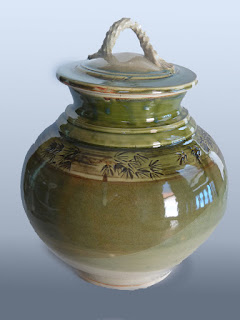Over the last few weeks, the plate,1/8 inch plywood, was covered with modeling paste, textured, and dried. Three coats of modeling paste in this manner and I was ready for step 2. This time I used a dremel tool on a router mount to create a series of pine needle type lines with branch areas added in. I cut the plate horizontally, getting rid of part for more interest.
This form worked to some degree, especially after spraying a bakers spray on it. This aided in the release of the slab from the form. You will notice I have nailed on two sticks of equal thickness to roll my rolling pin over. I had hoped that the design would give me a complete panel with the pine needle design indented. Not so.
In the finished slab rolled out over the form, the top is missing the border edge. The pine needle motif is coming out very well, and should not need a whole lot of work in the wet stage. I next tried pounding out the slab over the form, rolling in different directions, not rolling out the slab, pounding it down and then cutting the height of the sticks. None of the techniques gave me the crisp full border I was looking for.
At this point I believed that the problem was caused by the clay moving over the design plate when being rolled or pounded causing it to blur the border. I decided to try fully confining the slab to the plate, not allowing the clay to slide around as it got rolled or pounded into the form. This worked much better than any other attempts and with a little work will allow me to have 4 slabs to assemble and add wheel thrown parts for a jar. This preliminary form is to be a wedding jar for a good friend. A year late, sad to say.
 With a little smoothing in the wet stage, and careful trimming this slab
is ready to start drying to leather hard when I will bevel the edges of
the 4 pieces to join together. I will post later as things progress.
With a little smoothing in the wet stage, and careful trimming this slab
is ready to start drying to leather hard when I will bevel the edges of
the 4 pieces to join together. I will post later as things progress.Here is the basic box waiting for the foot ring, neck and lid. these will be wheel thrown and added on next. I have highlighted some of the decoration with white and green engobe, to help bring out the texture, and add light areas to the decoration under the glaze. The hazelnut brown clay is beautiful, but can darken glazes quite a bit.










